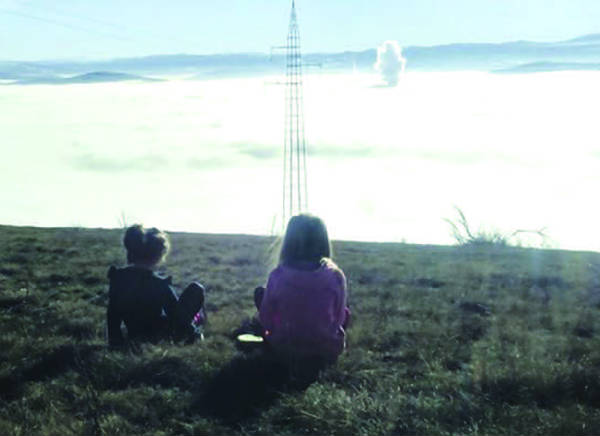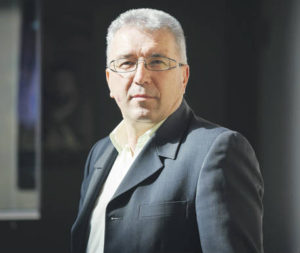Montenegro - the leader in black statistics: Cause of death – breathing polluted air

The World Health Organisation data show that 6 % of deaths in Podgorica, 12 % in Niksic and 22 % in Pljevlja are caused by air pollution. The authorities and polluters keep delaying actions which would help reverse the situation
At the end of January the alarm bells rang in Skopje due to dramatic air pollution which was 10 times more that allowed. The government prolonged school break, introduced free public transport and doubled parking fees so to discourage the use of vehicles. Furthermore the government recommended older people as well as those with chronic diseases not to go to work for a while.
However, the Montenegrin government did not bother itself with similar measures even though the air pollution in Podgorica was 18 days above the red line in the end of December. The alert in Pljevlja lasted 29 days in the same month. Furthermore, the Centre for Eco-Toxicological Research recorded in the end of November the greatest ever pollution in Plevlja- 23 times more than it is allowed.
The Government and the biggest polluters keep tossing responsibility to each other and always come up with new bureaucratic and other excuses so to evade strategic projects which would cut the air pollution. On the other hand the population’s health keeps deteriorating. Pljevlja is a city notorious for population exodus. CIN-CG & Monitor investigation points out to Podgorica and Niksic as seriously affected by air pollution.
The World Health Organization (WHO ) reports that 6 % of all deaths in Podgorica, 12 % in Niksic and 22 % in Pljevlja can be attributed to air pollution. The studies on these three towns point out to more than 250 premature deaths, 140 hospital admissions per year and a number of other health related issues due to exposure to particles which exceeds the WHO prescribed values- it is reported by the Institute of Public Health of Montenegro.
This institution states that the annual rate of premature mortality associated with exposure to particular pollutants in Montenegro is up to 60 times higher than the fatal road accidents.
In response to questions submitted by CIN-CG & Monitor, the Institute, cited details from The impact of air pollution on health in Montenegro, which was published in 2016 and compiled by WHO expert Dr. Michal Krzyzanowski, a visiting professor at Kings College in London.
High values of carcinogens benzo (a) pyrene in the PM 10 particles (diameter of less than 10 micrometers) exceed the boundaries of up to 15 times. This polycyclic aromatic hydrocarbon contained in coal tar is listed in the first group of carcinogens by the International Agency for Research on Cancer. It causes tumour of the ovary, lymph nodes, breasts, liver, digestive tract, lung, and leukemia.
Outdoors activities at your own risk
Record air pollution for years has ranked Pljevlja among the ten most polluted cities in Europe – according to WHO. The Institute of Public Health does not recommend outdoors activities there, especially when it comes to children and youth.
The Environmental Protection Agency in its response to CIN- CG & Monitor says that the air in Montenegro is primarily affected by solid fuels used for heating and nearly 200,000 registered motor vehicles with an average age of over 14 years. When it comes to heavy industry the main polluters are Plevlja Thermoelectric Plant, Pljevlja Coal Mine and Niksic Steel Plant (Toscelik).
"The air pollution problem exists in Tetovo, Prilep, Skopje, Zenica, Tuzla, Sarajevo, Uzice ...Thus when it comes to PM 10 and PM 2.5 particles Pljevlja have the same level as those cities. But, if we talk about heavy presence of other chemical elements - nitrogen, sulfur dioxide, thorium, uranium, and others then Pljevlja has outpaced all other cities by far" said Milorad Mitrovic, the executive of Breznica NGO.
He pointed out to the local health centre data released at the end of April last year. In just four months 35 women in Plevlja, aged between 35 and 50, were treated for breast cancer.
A few years ago the media published a sad story about 11 people in Pljevlja who were all family related. They all died of lungs cancer within a year. Dr Vesa Jecmenica (died in 2015) claimed in 2012 that a genetic mutation was in full swing in Pljevlja. Thus in addition to malignant diseases growth there was also a growth of congenital anomalies.
The Pljevlja Epidemiological Office reported 395 visits due to malignancy issues in 2017. The National Register of Malignant Neoplasms reported 175 newly registered cases of cancer in Pljevlja in 2013. There’s still no data for 2014.
Heating Plant, finally?
The latest government report boasts that “the government and its institutions are striving to improve the air quality in Montenegro, with special emphasis on Pljevlja“. The Environmental Protection Agency further elaborates the government efforts saying that they refer to construction of small power plants and heating system in Pljevlja. The authorities will also work to improve the air quality monitoring on the national level ...
The national power company (EPCG) announced the investment of €60 million in environmental protection, while the Pljevlja Coal Mine claims that it spends more than €10 million annually. The Agency states that a heating plant in Pljevlja would permanently solve the problems in the town center, provided that most homes are integrated in the heating network. This project would cost at least €20 million and has been talked about for years.
The mayor of Pljevlja, Mirko Djacic halted the heating plant tender in February last year, because the bids were declared invalid. Prior to the local elections in the spring of 2018, the municipal leaders and government officials were promising that pollution reduction would become tangible in the very same year. After they won the elections, the construction of the heating plant did not even begin. The contractor, Tim Company in Pljevlja, has not yet received the construction permit from the Ministry of Sustainable Development and Tourism (MORT).
“We expect MORT to issue the permit this week “ said Mervan Avdovic, the vice-chairman of Pljevlja’s City Council . He would not talk about deadlines for the project completion but he said that the construction would be swift.
Vaso Knezevic, a landscape architecture engineer and environmental activist in Pljevlja, explains that each polluter should be ordered certain things in order to help the environment. "The coal mine should reclaim the Jagnjilo Pit so to reduce the negative effects of the mining machinery. The dust from the open pit lands on the whole area... Then the thermoelectric power plant should install desulphurisation and slag removal filters…. The heating plant is perceived as the best solution and is spoken about for some 30 years, but we haven’t come to that in real terms yet" said Knezevic.
Mitrovic reminds that the authorities often stress the unfavorable climate and geographical position, because the town is surrounded by hills thus being deprived of air circulation.
“That is true, but the town is built in depression. Furthermore, over 120 million tonnes of material from the mine have been piled up on the hill. That disrupted the wind rose. There is no more north wind that used to clean the town’s air. The landfill of Culina Guka on the edge of the town prevents the air flow, while Velika Plijes and Mala Plijes landfills close the air flow on the town’s south. The coal mine changes the landscape and our living conditions. The abandoned open pit mines in Sumana and Borovici are filled with water and the surrounding landscape looks like Mars” says Mitrovic.
Running away as far as possible
The Coalition 27, which brings together the most important NGOs dealing with ecology, states that there are no strategies for air quality improvement in four municipalities, although the air pollution is on the rise. Implementation of the Pljevlja Strategy is still not satisfactory. There are no visible results yet and the level of pollution has remained the same as in the previous years.
Monstat- Statistical Office of Montenegro, records a negative migration balance for Pljevlja in the last decade. Pljevlja is number one in Montenegro when it comes to population exodus - the number of deaths exceeds the number of births by 144.
In the first week of February the Pljevlja City Council’s ruling majority rejected the proposal of the entire opposition to endorse emergency measures against pollution. The opposition asked the Council to press charges in court against the government for its deliberate obstruction of environmental protection plans. The opposition also wanted the EPCG power company and the Pljevlja Coal Mines to define the measures whereby they will tackle the overall pollution in accordance with the EU standards and recommendations.
Nonetheless the majority supported the “ongoing government efforts”.
Pollution and harmful effects
According to the Institute of Public Health, the so called rough PM10 particles increase the respiratory illnesses and mortality rates. They aggravate asthma, bronchitis and other similar diseases.
The EU regulations as well as Montenegrin tolerate an average PM10 daily value of 50 micrograms per cubic meter (μg/m3) which must not be exceeded more than 35 days a year. Official statistics show that from 2011 to 2018 the excessive presence of those particles in Podgorica lasted from 64 to 89 days a year, in Niksic from 104 to 147, and in Pljevlja from 144 to 217 days.
The average annual concentration of PM 10 particles should not exceed the ceiling of 40 μg/ m3. However Podgorica is near the line each year at 37.38, and in 2015 it was 41.91 μg/m3.
The data for Niksic show 43 to 62, while in Pljevlja those values go up to a staggering 99.81 μg/m3 recorded in 2015.
An increase in the average annual value of the "fine" PM 2.5 particles (diameter less than 2.5 micrometres) was recorded in Niksic and Pljevlja. The red line value is 25 μg/m3. In Niksic it is often at the border value, while in Pljevlja the recording exceeds 40 micrograms every year which qualifies the city among the most polluted in Europe.
EPCG: Plans and predictions and more lip service
The Montenegrin Electricity Utility (EPCG) replied to CIN CG & Monitor that the company was doing its best. They state that in 2013/14., they implemented a project that stabilized the Maljevac Landfill boundary wall. Moreover the expropriation of the nearby land is in progress so to afford a buffer zone. The Maljevac reclaim project is worth €20 million and another €40 million have been assigned for fixing Block 1 of the Pljevlja Thermoelectric Plant.
The EPCG says it’s is keen to reduce the content of oxides, sulfur and nitrogen in flue gases, then to construct a wastewater treatment plant, a new system of dry transport of ash, slag and chemical gypsum, as well as to remove asbestos from the cooling tower.
The Coal Mine AD Pljevlja told CIN CG & Monitor that it regularly conducts controls of waste oils and lubricants. Moreover they spend €150,000 each summer for sprinkling dirt roads to keep the dust down.
In early 2018 the sewage sludge purifier was put in action for the Cehotina River water treatment near the open pit mine there. The investment amounted to €280,000.
“We regularly conduct checks. The total cost of testing the air and water in the last five years reached €104,000 “said the Coal Mine press service.
Predrag NIKOLIĆ





